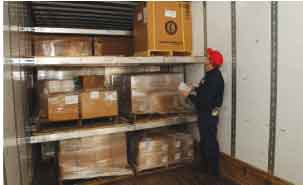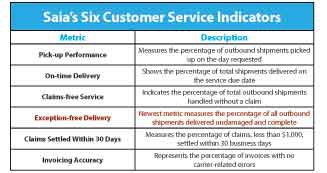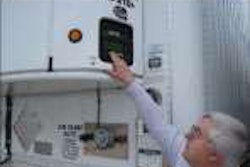Introduced an Exception-free Delivery metric to build customer confidence and improve service.
Saia
Johns Creek, Ga.
Without exception
Saia improves on its already-proven customer service with new measurement tool
By Jeff Crissey

After 18 months of programming, training and process improvements, Saia introduced its Customer Service Indicators (see chart, page 50), which it uses to track service performance for each customer on a daily basis. Saia also publishes companywide performance on a monthly basis on its Website for noncustomers to see.
It may sound like marketing spin on the surface, but Saia’s six CSIs now are embodied throughout the entire organization. “When we began, we wanted to make sure the CSI program was working and making a difference in our service,” says Sally Buchholz, vice president of marketing and customer service. “To us, it wasn’t about the advertising side of it, but ‘Could it make us a better company?’”
After its first year of implementation, Buchholz says the CSI program resulted in a 75 percent improvement overall in defects. In Claims Settled Within 30 Days, Saia had an 80 percent decrease in defects, as well as a 55 percent decrease in defects in On-time Delivery. Invoicing Accuracy wasn’t measured before the CSI program, but the company learned during its planning phase that it was important to customers. “If a customer’s invoice is consistently wrong, you do almost as much damage as not delivering their freight on time,” says Buchholz. “You cause just as much pain – just to a different part of their organization.”
 With its new Exception-free Delivery Customer Service Indicator, Saia is working to further improve the number of shipments delivered with no noted exceptions.
With its new Exception-free Delivery Customer Service Indicator, Saia is working to further improve the number of shipments delivered with no noted exceptions.
Before the CSI program started, Saia relied on the industry standard of showing clients a single service delivery report to make buying decisions. Buchholz says today it’s fun to make sales calls and go over the company’s CSI performance with customers because it’s not something they’re seeing from other carriers – especially considering how deep the philosophy runs throughout Saia’s organization as part of its operational processes. “It really has attracted new business, and people want to give us a try based on the fact that we’re a company that places an importance on improvement,” she says.
The next level: No exceptions
With advances in imaging technology since Saia began its CSI program, the need for the Proof of Delivery metric diminished. In its place, Saia has added Exception-free Delivery, a new metric it began developing two years ago that expands on the Claims-free Service metric to measure performance not just on shipments handled without claims, but also shipments delivered without a noted exception. “Essentially it lets the shipper know that their freight is being delivered in the exact same condition that it was when they gave it to us and gives them a true picture of the kind and quality of service we’re providing,” says Buchholz.

“When we do have an exception, we go back and review where our process fell short,” says Karla Staver, director of safety and claims prevention. To accomplish this, Saia began using their scanning systems to track where an exception took place in the distribution chain so the factors that caused the exception could be determined.
“If employees notice a scuffed box or puncture, they note it in the system so that when we go back and audit a specific bill, we can look and see that when ‘Joe’ moved it in Atlanta onto the trailer going to Houston, it was fine,” says Staver. “When we unloaded it in Houston, it was fine. However, when it reached the customer, they noted damage on the box. We can determine that when we loaded it for city delivery, we probably didn’t properly cushion that shipment.”
If a shipment is received with a noted exception, Saia’s region managers and terminal managers can go back and talk to the specific dockworker that loaded a particular shipment on a particular trailer.
“We’ve created an audit trail for every shipment and how it moves through our system and who touches it at various points,” says Buchholz. “Getting that technology in place has helped tremendously because otherwise you cannot pinpoint the problem.” And while Buchholz says that’s great for overall training, “individual counseling is such a huge component of improvement that getting [the technology] out there has been a big jump for us.”
Dock supervisors inspect each load prior to closing and rework issues with dock employees to coach and train on a continual basis. In addition to addressing issues at an individual level, Saia holds routine dock meetings to determine how to load freight better and sends out weekly training tips to dock employees that address loading and unloading practices specifically.
The company also has made significant investments in its securement methods to continue to improve on its Exception-free Delivery scores: Logistics posts are installed on 90 percent of Saia’s line-haul pup trailers, and cargo is secured with additional strapping, blocking and bracing materials as well as inflatable bags.
If exceptions occur because of the way the freight is packaged by the shipper, Saia works closely to find solutions.
“It’s a partnership,” says Buchholz. “We measure our performance anyway, and we’re looking to improve whether customers are paying attention or not. But we invite them to get involved because if we work together, [the CSI scores] are even more valuable.” n
Innovators profiles carriers and fleets that have found innovative ways to overcome trucking’s challenges.
If you know a carrier that has displayed innovation, contact Jeff Crissey at [email protected] or 800-633-5953.












